Seat belts
Important safety notes
WARNING
Always fasten your seat belt before driving off.
Always make sure all of your passengers are properly restrained. You and your passengers should always wear seat belts.
Failure to wear and properly fasten and position your seat belt greatly increases your risk of injuries and their likely severity in an accident.
If you are ever in an accident, your injuries can be considerably more severe without your seat belt properly buckled. Without your seat belt buckled, you are much more likely to hit the interior of the vehicle or be ejected from it. You can be seriously injured or killed.
In the same crash, the possibility of injury or death is lessened if you are properly wearing your seat belt. The air bags can only protect as intended if the occupants are properly wearing their seat belts.
WARNING
Never ride in a moving vehicle with the seat
backrest in an excessively reclined position as
this can be dangerous. You could slide under
the seat belt in a collision. If you slide under
it, the seat belt would apply force at the
abdomen or neck. That could cause serious
or even fatal injuries. The seat backrest and
seat belt provide the best restraint when the wearer is in a position that is as
upright as
possible and the seat belt is properly
positioned on the body.
WARNING
Never let more people ride in the vehicle than
there are seat belts available. Make sure
everyone riding in the vehicle is correctly
restrained with a separate seat belt. Never
use a seat belt for more than one person at a
time.
WARNING
Always have damaged seat belts or seat belts
that have been subjected to a load in an
accident replaced and the anchorages
checked.
Only use seat belts that have been approved by Mercedes-Benz.
Never tamper with seat belts. This can result in the unintended deployment of the Emergency Tensioning Devices or the failure to deploy when necessary.
Do not bleach or dye seat belts, as this may severely weaken them. In the event of a collision, they may be unable to provide adequate protection.
Have all work carried out only by qualified technicians. Consult a qualified specialist workshop.
The use of infant or child restraints is required by law in all 50 states, the District of Columbia, all U.S. territories and all Canadian provinces.
Even where this is not the case, all vehicle occupants should have their seat belts fastened when the vehicle is in motion.
See "Children in the vehicle" for further information on infants and children traveling in the vehicle, as well as on child restraint systems.
Correct use of the seat belts
WARNING
CORRECT USE OF SEAT BELTS
• Seat belts only work properly if they are
fastened correctly. Never wear seat belts in
any other way than as described in this
section, as that could result in serious
injuries in the event of an accident.
• All occupants should wear their seat belt at all times, because seat belts help reduce the likelihood of and potential severity of injuries in accidents, even if the vehicle overturns. The restraint system installed is equipped with SRS (driver's air bag, frontpassenger air bag, window curtain air bags), belt tensioners and belt force limiters.
The system is designed to enhance the protection offered to occupants who are wearing their seat belts correctly, in certain frontal impacts (front air bags and belt tensioners) and side impacts (window curtain air bags and belt tensioners) which exceed preset deployment thresholds.
• Never route the shoulder section of the seat belt under your arm, across your neck or anywhere other than across your shoulder. In the event of a frontal impact, your body would be moved too far forward.
This would increase the risk of head and neck injuries. The seat belt would then apply excessive force to the ribs or abdomen which could cause severe internal injuries to organs such as the liver or spleen.
Adjust the seat belt so that the upper part of the belt is as close as possible to the center of the shoulder. It should not touch the neck. Never route the belt under the shoulder. The height of the belt outlet can be altered to ensure correct usage.
• The lap belt should be routed as low as possible across the hips, not across the abdomen. If the lap belt is routed across the abdomen, it could cause serious injuries in the event of an impact.
• Never route the seat belt over rigid or fragile objects in or on your clothing, such as eyeglasses, pens, keys etc, as this could cause injuries.
• Always ensure that the seat belt is routed correctly. This is particularly important if you are wearing loose clothing.
• Only one person should use each seat belt at any one time. Never use a seat belt to restrain more than one person or route the belt around additional objects.
• Never wear seat belts when they are twisted. Otherwise, in the event of an impact, the full width of the seat belt is unavailable to distribute the force of the impact. The twisted seat belt routed across your body could cause injuries.
• Pregnant women should also wear a threepoint seat belt. The lap belt must always pass across your lap as low down as possible, i.e. across your hips; not across your abdomen.
• The seat backrest should be set as close to vertical as possible.
• Check the seat belt during the journey in order to make sure that it is correctly positioned.
• Never rest your feet on the dashboard or the seat. Always keep both feet on the floor in front of the seat.
• When using a seat belt to secure an infant restraint system, child restraint system or a child on a booster seat, always follow the child seat manufacturer's instructions.
WARNING
Do not pass seat belts over sharp edges. They
could tear.
Do not allow the seat belt to get caught in the door or in the seat adjustment mechanism.
This could damage the seat belt.
Never attempt to make modifications to seat belts. This could impair the effectiveness of the seat belts.
Fastening seat belts
Important safety notes
WARNING
According to accident statistics, children are
safer when properly restrained on the rear
seats than on the front-passenger seat. Thus,
we strongly recommend that children be
placed in the rear seat whenever possible.
Regardless of seating position, children 12 years old and under must be seated and properly secured in an appropriately sized child restraint system or booster seat recommended for the size and weight of the child. For additional information, see the "Children in the vehicle" section.
A child's risk of serious or fatal injuries is significantly increased if the child restraints are not properly secured in the vehicle and/ or the child is not properly secured in the child restraint.
WARNING
Children 12 years old and under must never
ride in the front seat, except in a Mercedes-
Benz authorized BabySmart™ compatible
child seat, which operates with the
BabySmart™ system installed in the vehicle
to deactivate the front passenger front air bag
when it is installed properly. Otherwise they
will be struck by the air bag when it inflates in
a crash. If this happens, serious or fatal injury
will result.
Three-point seat belt, front
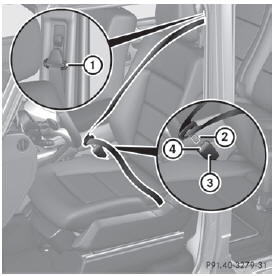
► Adjust the seat and move the backrest to an almost vertical position .
► Pull the seat belt smoothly through belt sash guide 1.
► Without twisting it, guide the shoulder section of the seat belt across the middle of your shoulder and the lap section across your hips.
► Engage belt tongue 2 in buckle 3.
► If necessary, adjust the seat belt to the appropriate height .
► If necessary, pull upwards on the shoulder section of the seat belt to tighten the belt across your body.
Further information on releasing the seat belts with release button 4.
Three-point seat belt in the rear, center
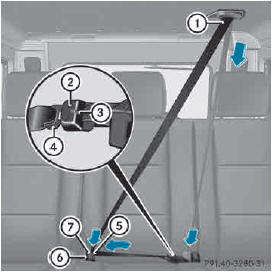
1 Bracket for seat belt tongues
2 Belt buckle for fixed belt tongue
3 Release button for fixed belt tongue
4 Fixed belt tongue
5 Belt buckle for moveable belt tongue
6 Release button for moveable belt tongue
7 Moveable belt tongue
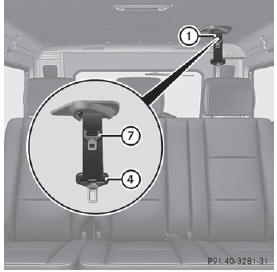
► Pull both seat belt tongues 4 and 7 from bracket 1.

► Pull the seat belt smoothly from the seat belt retractor.
► Engage fixed seat belt tongue 4 in buckle 2.
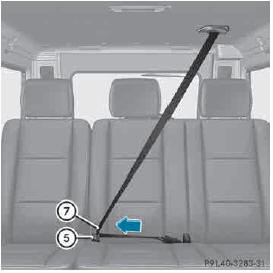
► Pull movable seat belt tongue 7 and route the seat belt across your body. Without twisting it, guide the shoulder section of the seat belt across the middle of your shoulder and the lap section across your hips.
► Engage movable seat belt tongue 7 in buckle 5.
► If necessary, pull upwards on the shoulder section of the seat belt to tighten the belt across your body.
Further information on releasing the seat belts with release buttons 6 and 3.
Special seat belt retractor
All seat belts in the vehicle with the exception of the driver's are equipped with a special seat belt retractor, to which a child restraint system can be secured. For further information on the "special seat belt retractor" .
Belt height adjustment
You can adjust the belt height on the driver's and front-passenger seat, as well as on the outer rear seats.
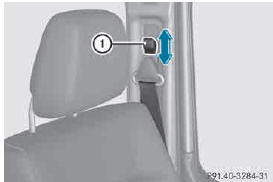
Adjust the height so that the upper part of the seat belt is routed across the center of your shoulder.
► To raise: slide the belt sash guide upwards.
The belt sash guide engages in various positions.
► To lower: draw belt sash guide release 1 forwards and hold it.
► Slide the belt sash guide downwards.
► Let go of belt sash guide release 1 and make sure that the belt sash guide has engaged.
Releasing seat belts
Make sure that the seat belt is fully rolled up. Otherwise, the seat belt or belt tongue will be trapped in the door or in the seat mechanism. This could damage the door, the door trim panel and the seat belt.
Damaged seat belts can no longer fulfill their protective function and must be replaced. Visit a qualified specialist workshop.
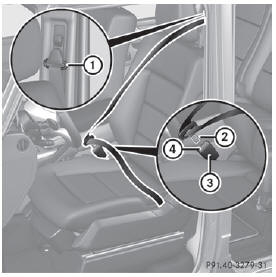
► Press release button 4 of buckle 3 and guide belt tongue 2 back towards belt sash guide 1.
Belt warning for the driver and front passenger
The  seat belt warning lamp in
seat belt warning lamp in
the
instrument cluster is a reminder for all
occupants to fasten their seat belts.
Regardless of whether the driver's and frontpassenger
seat belts have already been
fastened, the  seat belt warning
seat belt warning
lamp
lights up for six seconds each time the engine
is started. It then goes out once the driver and
the front passenger have fastened their seat
belts.
If the driver and/or front passenger have not fastened their seat belts after the engine has been started, an additional warning tone sounds. This warning tone switches off after approximately six seconds or once the driver's seat belt is fastened.
If after six seconds, the driver or front
passenger have not fastened their seat belts
and the doors are closed:
• the  seat belt warning lamp
seat belt warning lamp
remains
illuminated as long as either the driver's or
front-passenger seat belt is not fastened
• and if vehicle speed once exceeds
15 mph (25 km/h), the  seat belt
seat belt
warning lamp lights up. A warning tone also
sounds with increasing intensity for a
maximum of 60 seconds or until the driver
or front-passenger seat belt has been
fastened.
If the driver or front-passenger seat belt is
unfastened while the vehicle is in motion, the
 seat belt warning lamps light up
seat belt warning lamps light up
and a
warning tone sounds again.
The warning tone ceases even if the driver or
front-passenger seat belt has still not been
fastened after 60 seconds. The  seat
seat
belt
warning lamp stops flashing but remains
illuminated.
After the vehicle comes to a standstill, the
warning tone is reactivated and the 
seat
belt warning lamp flashes again if the vehicle
speed again exceeds 15 mph (25 km/h).
The  seat belt warning lamp only
seat belt warning lamp only
goes
out if:
• both the driver and the front passenger
have fastened their seat belts.
or
• the vehicle is stationary and a door is open.
Further information about the 
seat
belt warning lamp .
Emergency Tensioning Devices, belt force limiters
WARNING
Pyrotechnic ETDs that were activated must be
replaced.
For your safety, when disposing of the pyrotechnic ETDs always follow our safety instructions. These are available at any authorized Mercedes-Benz Center.
If the front-passenger seat is not occupied, do not engage the seat belt tongue in the buckle on the frontpassenger seat. Otherwise, the Emergency Tensioning Device could be triggered in the event of an accident.
► In order to ensure that the pyrotechnic Emergency Tensioning Devices have not been triggered, always have the seat belts checked after an accident.
If the Emergency Tensioning Devices have been triggered, they must be replaced.
The seat belts for the front seats and rear outer seats are equipped with ETDs and seat belt force limiters.
The ETDs on the driver's and front-passenger seat consist of pyrotechnic belt buckle tensioners and belt anchor installation tensioners that are triggered together. The belt buckle tensioner is mounted on the Bpillar and the belt anchor installation is mounted on the side of the seat. After deploying, both tensioners must always be replaced.
The ETDs tighten the seat belts in an accident, pulling them close against the body.
The ETDs do not correct incorrect seat positions or incorrectly fastened seat belts.
The ETDs do not pull vehicle occupants back towards the backrest.
When triggered, seat belt force limiters help to reduce the peak force exerted by the seat belt on the vehicle occupant.
The front seat belt force limiters are synchronized with the front air bags, which take on a part of the deceleration force. Thus, the force exerted on the occupant is distributed over a greater area.
The ETDs can only be activated when: • the SmartKey is in position 1 or 2 in the ignition lock.> R the restraint systems are operational; see "SRS warning lamp" .> R the belt tongue is engaged in the buckle on each of the lap-shoulder belts in the front.> R the front-passenger seat is occupied and the belt tongue is engaged in the buckle on the front-passenger side
The Emergency Tensioning Devices are triggered depending on the type and severity of an accident, if:> R in the event of a head-on or rear-end collision, the vehicle decelerates or accelerates rapidly in a longitudinal direction during the initial stages of the impact> R if, in the event of a side impact, on the side opposite the impact the vehicle decelerates or accelerates rapidly in a lateral direction> R in certain situations where the vehicle overturns and the system determines that it can provide additional protection
If the ETDs are deployed, you will hear a bang, and a small amount of powder may also be released. Only in rare cases will the bang affect your hearing. The powder that is released generally does not constitute a health hazard. The 6 SRS warning lamp lights up.
See also:
PRE-SAFE® (anticipatory occupant
protection system)
WARNING
The PRE-SAFE® system reduces the impact of
an accident on vehicle occupants, as long as
their seat belts have been fastened correctly.
Although your vehicle is equipped with a PRESAFE
® ...
Immobilizer
► To activate: remove the SmartKey from
the ignition lock.
► To deactivate: switch on the ignition.
The immobilizer prevents your vehicle from
being started without the correct Smart ...
Tire labeling
Tire labeling overview
The following markings are on the tire in
addition to the tire name (sales designation)
and the manufacturer's name:
1 Uniform tire Quality Grading Standard
2 DOT, Tire ...
